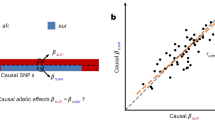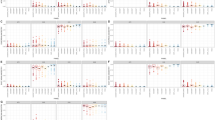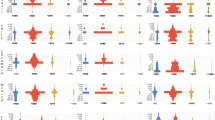Abstract
The degree of admixture in Brazil between historically isolated populations is complex and geographically variable. Studies differ as to what the genetic and phenotypic consequences of this mixing have been. In Northeastern Brazil, we enrolled 522 residents of Salvador and 620 of Fortaleza whose distributions of self-declared color were comparable to those in the national census. Using the program Structure and principal components analysis there was a clear correlation between biogeographic ancestry and categories of skin color. This correlation with African ancestry was stronger in Salvador (r=0.585; P<0.001) than in Fortaleza (r=0.236; P<0.001). In Fortaleza, although self-declared blacks had a greater proportion of European ancestry, they had more African ancestry than the other categories. When the populations were analyzed without pseudoancestors, as in some studies, the relationship of ‘race’ to genetic ancestry tended to diffuse or disappear. The inclusion of different African populations also influenced ancestry estimates. The percentage of unlinked ancestry informative markers in linkage disequilibrium, a measure of population structure, was 3–5 times higher in both Brazilian populations than expected by chance. We propose that certain methods, ascertainment bias and population history of the specific populations surveyed can result in failure to demonstrate a correlation between skin color and genetic ancestry. Population structure in Brazil has important implications for genetic studies, but genetic ancestry is irrelevant for how individuals are treated in society, their health, their income or their inclusion. These track more closely with perceived skin color than genetic ancestry.
Similar content being viewed by others
Log in or create a free account to read this content
Gain free access to this article, as well as selected content from this journal and more on nature.com
or
References
Salzano FM : Interethnic variability and admixture in Latin America-social implications. Rev Biol Trop 2004; 52: 405–415.
Callegari-Jacques SM, Grattapaglia D, Salzano FM et al. Historical genetics: spatiotemporal analysis of the formation of the Brazilian population. Am J Hum Biol 2003; 15: 824–834.
Nascimento AS, José Fonseca D : Classifications and identities: changes and continuities in the definitions of color and race; in Petruccelli JL, Saboia AL (eds): Ethno-Racial Characteristics of the Population: Classifications and Identities. Rio de Janeiro: Instituto Brasileiro de Geografia e Estatística, 2013, pp 51–82.
Parra FC, Amado RC, Lambertucci JR, Rocha J, Antunes CM, Pena SD : Color and genomic ancestry in Brazilians. Proc Natl Acad Sci USA 2003; 100: 177–182.
Pimenta JR, Zuccherato LW, Debes AA et al. Color and genomic ancestry in Brazilians: a study with forensic microsatellites. Hum Hered 2006; 62: 190–195.
Blanton RE, Silva LK, Morato VG et al. Genetic ancestry and income are associated with dengue hemorrhagic fever in a highly admixed population. Eur J Hum Genet 2008; 16: 762–765.
Lins TC, Vieira RG, Abreu BS et al. Genetic heterogeneity of self-reported ancestry groups in an admixed Brazilian population. J Epidemiol 2011; 21: 240–245.
Manta FS, Pereira R, Caiafa A, Silva DA, Gusmao L, Carvalho EF : Analysis of genetic ancestry in the admixed Brazilian population from Rio de Janeiro using 46 autosomal ancestry-informative indel markers. Ann Hum Biol 2013; 40: 94–98.
Barrett JC, Fry B, Maller J, Daly MJ : Haploview: analysis and visualization of LD and haplotype maps. Bioinformatics 2005; 21: 263–265.
Pritchard JK, Stephens M, Donnelly P : Inference of population structure using multilocus genotype data. Genetics 2000; 155: 945–959.
Collins-Schramm HE, Chima B, Morii T et al. Mexican American ancestry-informative markers: examination of population structure and marker characteristics in European Americans, Mexican Americans, Amerindians and Asians. Hum Genet 2004; 114: 263–271.
Hernandez-Suarez G, Sanabria MC, Serrano M et al. Genetic ancestry is associated with colorectal adenomas and adenocarcinomas in Latino populations. Eur J Hum Genet 2014; 10: 1208–1216.
Lindenau JD, Salzano FM, Guimaraes LS et al. Distribution patterns of variability for 18 immune system genes in Amerindians—relationship with history and epidemiology. Tissue Antigens 2013; 82: 177–185.
Amigo J, Salas A, Phillips C, Carracedo A : SPSmart: adapting population based SNP genotype databases for fast and comprehensive web access. BMC Bioinformatics 2008; 9: 428.
Torres-Roldana RL, Garcia-Cascoa A, Garcia-Sanchezb PA : CSpace: an integrated workplace for the graphical and algebraic analysis of phase assemblages on 32-bit wintel platforms. Comp Geosci 2000; 26: 779–793.
R Core Team: R: A Language and Environment for Statistical Computing. Vienna, Austria: R Foundation for Statistical Computing, 2014.
Shriver MD, Mei R, Parra EJ et al. Large-scale SNP analysis reveals clustered and continuous patterns of human genetic variation. Hum Genomics 2005; 2: 81–89.
Halder I, Kip KE, Mulukutla SR et al. Biogeographic ancestry, self-identified race, and admixture-phenotype associations in the Heart SCORE Study. Am J Epidemiol 2012; 176: 146–155.
Pfaff CL, Parra EJ, Bonilla C et al. Population structure in admixed populations: effect of admixture dynamics on the pattern of linkage disequilibrium. Am J Hum Genet 2001; 68: 198–207.
Excoffier L, Laval G, Schneider S : Arlequin ver. 3.0: an integrated software package for population genetics data analysis. Evol Bioinform Online 2005; 1: 47–50.
Jorde LB, Watkins WS, Bamshad MJ et al. The distribution of human genetic diversity: a comparison of mitochondrial, autosomal, and Y-chromosome data. Am J Hum Genet 2000; 66: 979–988.
Leite TK, Fonseca RM, de Franca NM, Parra EJ, Pereira RW : Genomic ancestry, self-reported “color” and quantitative measures of skin pigmentation in Brazilian admixed siblings. PLoS One 2011; 6: e27162.
Pena SD, Di Pietro G, Fuchshuber-Moraes M et al. The genomic ancestry of individuals from different geographical regions of Brazil is more uniform than expected. PLoS One 2011; 6: e17063.
Santos RV, Fry PH, Monteiro S et al. Color, race, and genomic ancestry in Brazil: dialogues between anthropology and genetics. Curr Anthropol 2009; 50: 787–819.
Cardena MM, Ribeiro-Dos-Santos A, Santos S, Mansur AJ, Pereira AC, Fridman C : Assessment of the relationship between self-declared ethnicity, mitochondrial haplogroups and genomic ancestry in Brazilian individuals. PLoS One 2013; 8: e62005.
Muniz YC, Ferreira LB, Mendes-Junior CT, Wiezel CE, Simoes AL : Genomic ancestry in urban Afro-Brazilians. Ann Hum Biol 2008; 35: 104–111.
Pena SD, Bastos-Rodrigues L, Pimenta JR, Bydlowski SP : DNA tests probe the genomic ancestry of Brazilians. Braz J Med Biol Res 2009; 42: 870–876.
Queiroz EM, Santos AM, Castro IM et al. Genetic composition of a Brazilian population: the footprint of the Gold Cycle. Genet Mol Res 2013; 12: 5124–5133.
Santos NP, Ribeiro-Rodrigues EM, Ribeiro-Dos-Santos AK et al. Assessing individual interethnic admixture and population substructure using a 48-insertion-deletion (INSEL) ancestry-informative marker (AIM) panel. Hum Mutat 2009; 31: 184–190.
Reich D, Patterson N, Campbell D et al. Reconstructing Native American population history. Nature 2012; 488: 370–374.
Felix GES, Abe-Sandes K, Bonfim TM et al. Ancestry informative markers and complete blood count parameters in Brazilian blood donors. Rev Bras Hematol Hemoter 2010; 32: 282–285.
Adorno EV, Zanette A, Lyra I et al. The beta-globin gene cluster haplotypes in sickle cell anemia patients from Northeast Brazil: a clinical and molecular view. Hemoglobin 2004; 28: 267–271.
Silva LB, Gonçalves RP, Rabenhorst SHB : [Analysis of sickle cell anemia haplotypes in Fortaleza reveals the ethnic origins of the population of Ceará state]. J Bras Patol Med Lab 2009; 45: 115–118.
Parra EJ, Kittles RA, Shriver MD : Implications of correlations between skin color and genetic ancestry for biomedical research. Nat Genet 2004; 36: S54–S60.
Krieger H, Morton NE, Mi MP, Azevedo E, Freire-Maia A, Yasuda N : Racial admixture in north-eastern Brazil. Ann Hum Genet 1965; 29: 113–125.
Azevêdo ES, Chautard-Freire-Maia EA, Freire-Maia N et al. Mating types in a mixed and multicultural population of Salvador. Rev Bras Genet 1986; 9: 487–496.
Risch N, Choudhry S, Via M et al. Ancestry-related assortative mating in Latino populations. Genome Biol 2009; 10: R132.
Tang H, Peng J, Wang P, Risch NJ : Estimation of individual admixture: analytical and study design considerations. Genet Epidemiol 2005; 28: 289–301.
Acknowledgements
This work was supported by grants from the NIH (R21 AI056263), the CNPq:(Process 506081/2003–6) and resources provided by the Ministry of Health, Brazil.
Author information
Authors and Affiliations
Corresponding author
Ethics declarations
Competing interests
The authors declare no conflict of interest.
Additional information
Supplementary Information accompanies this paper on European Journal of Human Genetics website
Supplementary information
Rights and permissions
About this article
Cite this article
Magalhães da Silva, T., Sandhya Rani, M., de Oliveira Costa, G. et al. The correlation between ancestry and color in two cities of Northeast Brazil with contrasting ethnic compositions. Eur J Hum Genet 23, 984–989 (2015). https://doi.org/10.1038/ejhg.2014.215
Received:
Revised:
Accepted:
Published:
Issue date:
DOI: https://doi.org/10.1038/ejhg.2014.215
This article is cited by
-
Mutational spectrum of breast cancer susceptibility genes among women ascertained in a cancer risk clinic in Northeast Brazil
Breast Cancer Research and Treatment (2022)
-
Origin and age of the causative mutations in KLC2, IMPA1, MED25 and WNT7A unravelled through Brazilian admixed populations
Scientific Reports (2018)
-
Admixture, Genetics and Complex Diseases in Latin Americans and US Hispanics
Current Genetic Medicine Reports (2018)
-
On the use of Chinese population as a proxy of Amerindian ancestors in genetic admixture studies with Latin American populations
European Journal of Human Genetics (2016)
-
Self-reported race/ethnicity in the age of genomic research: its potential impact on understanding health disparities
Human Genomics (2015)



